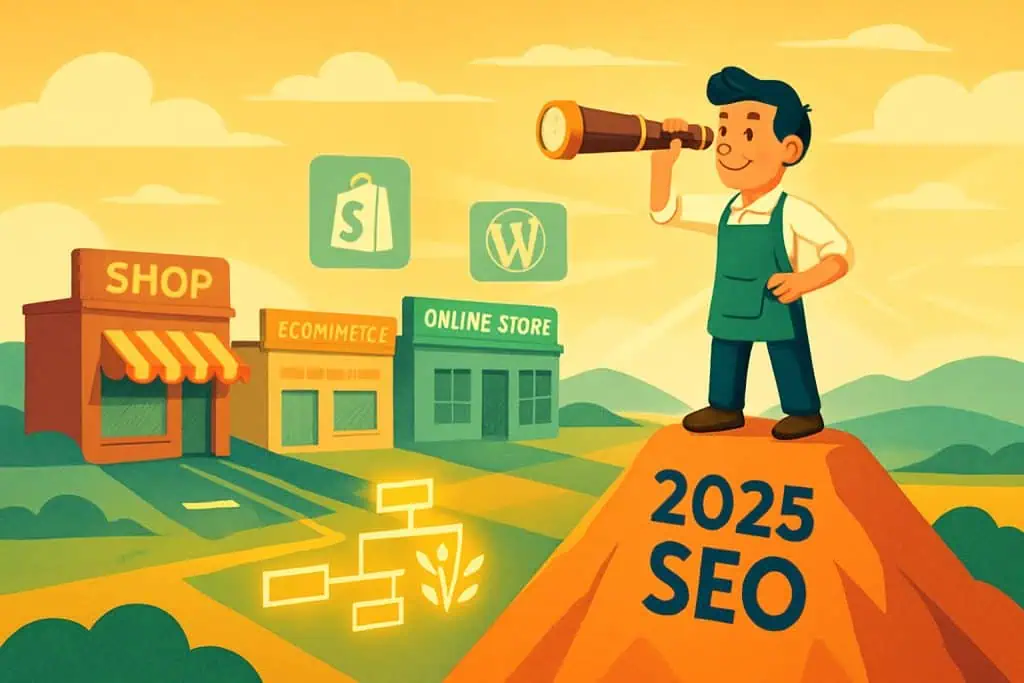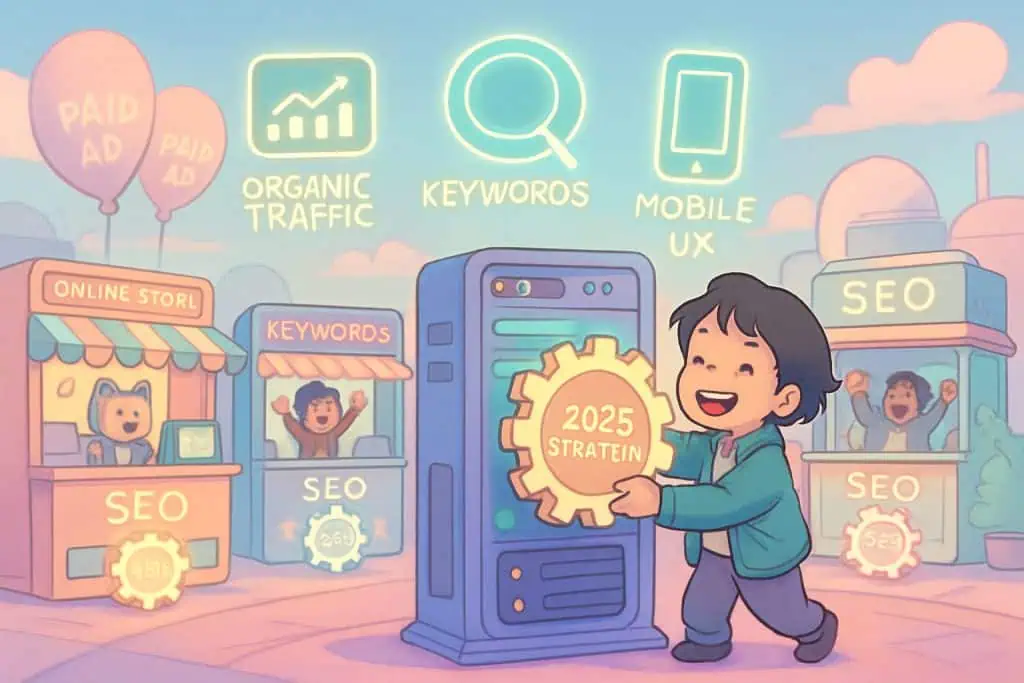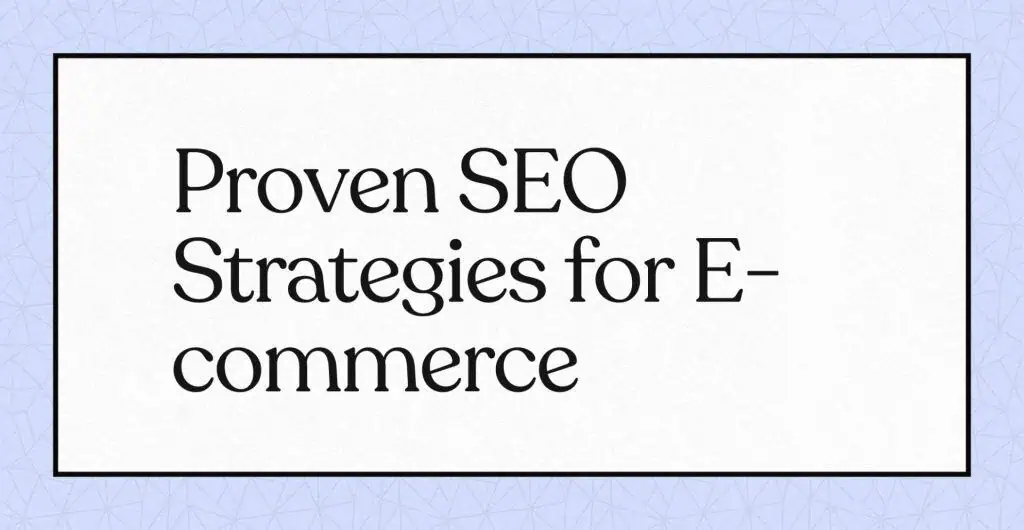Summary
SEO strategies for e-commerce in 2025 prioritize mobile-first indexing, Core Web Vitals, structured data, and fast on-page fixes that drive ROI without heavy ad spend. The guide details platform tactics for Shopify and WordPress WooCommerce, including long-tail keyword targeting, unique product descriptions, internal linking, image optimization, and technical SEO audits. Growth levers include pillar content, authority link building, local SEO via Google Business Profile, and mobile UX improvements like speed, simplified checkout, and voice-search friendly FAQs.
Are you a small online store owner, feeling like your amazing products are getting lost in the crowd of competitors? You’re not alone. The search results are dominated by big retailers, leaving thousands of small e-commerce businesses struggling to stand out. But here’s the good news: with the right SEO strategies for e-commerce , you can significantly increase your visibility without relying heavily on paid ads.
Recent research shows that SEO strategies for e-commerce remain among the most cost-effective marketing channels for small and medium-sized businesses, delivering consistent returns long after the initial investment. Unlike paid campaigns, SEO builds long-term traffic and brand equity.
This comprehensive guide explores proven SEO strategies for e-commerce in 2025 from quick-win tactics for fast gains to platform-specific approaches tailored for Shopify and WordPress store owners aiming for sustainable growth.
The Current E-commerce SEO industry for SMEs in 2025
The digital marketplace has evolved dramatically, creating challenges and opportunities for small online retailers. The exponential advancement of digital technologies has reshaped the global e-commerce scene, driving innovation while intensifying competition. Understanding these shifts is not just crucial; it’s empowering, allowing you to develop effective SEO strategies and take control of your online visibility.
Mobile commerce now dominates the market, with over 60% of online searches happening on mobile devices and nearly 44% of total eCommerce sales in the U.S. expected to come from mobile by the end of 2025. This shift has prompted Google to prioritize mobile-friendly websites, with the search giant now using mobile-first indexing exclusively. As of July 5, 2024, Googlebot no longer crawls with the desktop Googlebot, making mobile optimization essential for search visibility.
Cross-border opportunities have expanded significantly for small e-commerce businesses. Cross-border e-commerce leverages digital technologies like AI, IoT, and blockchain to enhance network flexibility and optimize delivery systems. This allows even small retailers to reach global markets, increasing competitive pressure from international sellers.
The rise of generative AI has also transformed SEO practices, with tools that can assist in content creation, keyword research, and competitive analysis. However, SMEs must navigate challenges related to the homogeneity and reliability of AI output, particularly when creating unique product descriptions and marketing content.

Quick-Win SEO Strategies for Immediate ROI
While comprehensive SEO is a long-term investment, several strategies can deliver relatively fast improvements in search visibility and traffic for e-commerce SMEs. These quick-win strategies offer immediate results, giving you a sense of progress and motivating you to continue your SEO efforts.
Polish Your Google Business Profile for Local Visibility
For e-commerce businesses with physical locations, optimizing your Google Business Profile (formerly Google My Business) is vital. This free tool is your shortcut to appearing locally, especially for those valuable “near me” queries. The best part? You control what appears in these evident results.
Complete every section of your profile, add high-quality photos, maintain accurate business hours, and respond promptly to reviews. Local SEO thrives on credibility and activity, making a well-maintained Google Business Profile essential for standing out against competitors still fumbling with their online presence.
Target Low-Competition Long-Tail Keywords
Small e-commerce businesses can’t compete with giants like Amazon for broad keywords. Instead, focus on getting hyper-specific with long-tail keywords with lower competition but higher conversion potential. Rather than targeting “running shoes,” aim for “best trail running shoes for beginners with flat feet.”
Use tools like Google’s Keyword Planner or Ubersuggest to find these specialized keywords, then weave them naturally into your product descriptions, blog posts, and FAQs. This strategy helps you capture searchers who know exactly what they need and are closer to purchasing.
Fine-Tune On-Page SEO Elements
Optimizing key on-page elements that influence search rankings can quickly achieve improvements. The best part? These changes are relatively simple and don’t require significant technical expertise or investment, making them accessible to all e-commerce SMEs.
- Update meta titles and descriptions with your target keywords while keeping titles under 60 characters for optimal display in search results.
- Optimize your heading structure using H1 for main page titles and H2/H3 for supporting information, ensuring keywords appear naturally in these headings.
- Add alt text to all product images, describing them accurately while incorporating relevant keywords.
- Enable breadcrumbs to improve site navigation and help search engines understand your site structure.
These relatively simple changes can yield noticeable improvements in search visibility without requiring significant technical expertise or investment.
Platform-Specific SEO: Shopify vs. WordPress
Different e-commerce platforms require tailored SEO approaches. Here’s how optimization strategies differ between small online retailers’ two most popular platforms.
Shopify SEO Tactics
Shopify provides a solid SEO foundation out of the box but requires specific optimizations to maximize performance:
Optimize Product Pages and Metadata: Shopify makes updating meta titles and descriptions for each page easy. Focus on creating unique, keyword-rich titles under 60 characters and compelling meta descriptions encouraging clicks. Use the primary keyword near the beginning of the title for maximum impact.
Leverage SEO Apps: While Shopify’s built-in SEO features are good, apps like SEO Booster, Smart SEO, and Crush. Pics can enhance your optimization efforts. These tools can automate image compression and meta tag creation and identify SEO opportunities specific to your store.
Enhance Content Strategy: Consider transforming category pages into landing pages by adding informative content at the top and bottom. This provides more opportunities to incorporate keywords naturally while adding value for visitors. For example, an “organic skincare” category page could include educational content about ingredients and benefits.
Implement Effective Internal Linking: Use contextual links within product descriptions to guide users to related products or blog posts, creating a natural path through your site. This keeps visitors engaged longer, reduces bounce rates, and reinforces your keyword strategy by aligning anchor texts with crucial search terms.
WordPress SEO Tips for WooCommerce
WordPress with WooCommerce offers extensive flexibility, but successful results depend on applying the right SEO strategies for e-Commerce and being hands-on with optimization.
- Select the Right SEO Plugins: WordPress thrives on its plugin ecosystem. Tools like Yoast SEO, All in One SEO, or Rank Math are essential SEO strategies for e-Commerce that help optimize content, manage sitemaps, and identify technical issues.
- Create SEO-Friendly URL Structures: Customizing your permalinks is a core SEO strategy for e-Commerce. Use clear, keyword-rich URLs that improve both user experience and search engine understanding. Avoid default URLs with unnecessary parameters or numbers.
- Implement Structured Data: While WooCommerce themes include basic schema, plugins like Schema Pro or Structured Data for WooCommerce take your SEO strategies for e-Commerce further. Optimized product schema enables rich snippets showing price, availability, and reviews directly in Google search results.
- Optimize for Mobile and Speed: Responsive design and speed are non-negotiable in SEO strategies for e-Commerce. Test performance regularly with tools like Google PageSpeed Insights and make necessary adjustments to maintain fast load times.
While Shopify provides a more streamlined experience, WordPress with WooCommerce allows for deeper customization. For those willing to invest in SEO strategies for e-Commerce, the platform offers unmatched control and scalability.
On-Page SEO for Online Stores: Creating Content That Converts
On-page SEO for e-commerce extends beyond metadata optimization to the actual content that drives conversions. These strategies help small online retailers create pages that satisfy search engines and customers.
Create Unique Product Descriptions That Sell
Product descriptions shouldn’t just repeat manufacturer specifications- they should tell a story that resonates with potential buyers. Unique, detailed descriptions help distinguish your products from competitors while providing search engines with fresh content to index.
When writing product descriptions, naturally incorporate primary and secondary keywords, focus on benefits rather than features, address common customer questions, and use persuasive language that speaks to your target audience’s needs. Aim for at least 300 words per description to provide sufficient context for search engines while giving customers the information they need to make purchasing decisions.
Optimize Images for Search and User Experience
Product images play a crucial role in e-commerce SEO. Beyond adding alt text with relevant keywords, compress images to improve page load times without sacrificing quality. Consider implementing lazy loading so images only load when users scroll to them, improving page speed performance.
Additionally, use descriptive, keyword-rich file names before uploading images (e.g., “organic-cotton-blue-t-shirt.jpg” rather than “IMG12345.jpg”). This provides search engines with additional context about your visual content
Leverage User-Generated Content
Customer reviews provide fresh, relevant content incorporating long-tail keywords and addressing specific product attributes. Implement a system to encourage customers to leave detailed reviews and consider prominently featuring exceptional reviews on product pages.
User-generated content signals to search engines that your site is active and trusted by customers while providing social proof influencing purchasing decisions.
This creates a virtuous cycle where SEO improvements lead to more sales, generating more reviews and enhancing SEO performance.
Technical SEO Fundamentals for E-commerce SMEs
Technical SEO forms the foundation of e-commerce search visibility. Without these fundamental elements, even the best content strategies will struggle to gain traction.
Improve Site Speed for Better Rankings and Conversions
Site speed directly impacts both search rankings and conversion rates. For e-commerce sites, even a one-second delay in page loading can reduce conversions by up to 7%. Use Google PageSpeed Insights to identify specific improvements for your store.
Common speed optimization techniques include:
- Compressing images without sacrificing quality
- Implementing browser caching to reduce load times for returning visitors
- Minifying CSS and JavaScript files
- Using a content delivery network (CDN) to serve content from servers geographically close to visitors
- Reducing the number of plugins and unnecessary code
Speed optimization has become even more critical, with Google’s Core Web Vitals metrics now playing a significant role in search rankings.
Implement Structured Data for Enhanced Search Results
Structured data (schema markup) helps search engines understand your content better and can enable rich snippets in search results. For e-commerce sites, product schema is particularly valuable, displaying information like price, availability, and reviews directly in search listings.
While implementing structured data requires technical knowledge, many e-commerce platforms offer plugins or apps that simplify the process. Proper schema implementation can significantly improve click-through rates from search results by making your listings more visually appealing and informative than competitors’.
Fix Technical Issues That Harm Rankings
Regularly audit your site for technical issues using tools like Google Search Console, which identifies specific problems affecting your search performance.
Common technical issues for e-commerce sites include:
- Duplicate content from product variations
- Broken links from discontinued products
- Orphaned pages not connected to your site’s main navigation
- Crawl errors preventing search engines from accessing important pages
- Missing or improper canonical tags
- Thin content on category pages
Addressing these issues often produces significant ranking improvements, as they remove barriers preventing search engines from correctly understanding and indexing your content.
Content Strategy Using Pillar Pages for E-commerce Growth
Creating high-quality content is essential for e-commerce SEO success, but random blog posts won’t deliver maximum results. A structured content strategy built around pillar pages can dramatically increase organic traffic and establish topical authority.
What Are Pillar Pages and Why They Matter for E-commerce
Pillar pages, called content pillars, are comprehensive content that serves as the cornerstone of a topic cluster. They provide an in-depth overview of a broad topic and link to related cluster content pieces that dive deeper into specific subtopics.
For e-commerce SMEs, pillar pages help establish authority on subjects related to your products while creating a logical content structure that search engines reward with higher rankings. This approach allows you to rank for thousands of keywords by creating a network of interlinked, relevant content.
Creating Effective E-commerce Pillar Content
When creating pillar pages for your store, aligning them with main product categories is essential for effective SEO strategies for e-Commerce. If you sell outdoor gear, a pillar page like “Complete Guide to Hiking Gear for Beginners” can act as the central hub, linking to cluster content such as tents, backpacks, and hiking boots.
A high-performing SEO strategies for e-Commerce pillar page should:
- Provide in-depth coverage of the main topic, aiming for 2,000+ words
- Use relevant keywords naturally to strengthen your SEO strategies for e-Commerce
- Link internally to cluster content like product category pages and buying guides
- Address common customer questions and solve key pain points
- Include visual elements—images, charts, or videos—to boost engagement and support SEO strategies for e-Commerce
This structured approach to SEO strategies for e-Commerce helps search engines understand your topical authority while guiding customers through their buying journey with valuable, well-organized content.
Link Building for E-commerce: Quality Over Quantity
Link building remains one of the most powerful SEO strategies, though it can be challenging for small e-commerce businesses to compete with larger retailers’ massive backlink profiles.
Guest Blogging on Industry-Relevant Sites
Write guest posts for websites related to your industry to gain authoritative backlinks while showcasing your expertise. Focus on quality over quantity, targeting sites with engaged audiences that match your customer demographics.
Develop content that provides genuine value rather than thinly disguised product promotions when pursuing guest blogging opportunities. Share unique insights, original research, or helpful tutorials that naturally incorporate mentions of your products or services where relevant.
Create Linkable Assets That Attract Natural Backlinks
Develop high-quality resources that others will want to link to organically, such as:
- Industry studies or original research
- Comprehensive buying guides
- Interactive tools or calculators
- Infographics visualizing complex information
- Free resources related to your products
These assets serve dual purposes: attracting high-quality backlinks from industry publications and providing valuable content for your audience. For example, a kitchen supply store might create a definitive guide to knife types and maintenance, which both cooking blogs and culinary schools might reference.
Build Relationships with Influencers and Bloggers
Partner with relevant influencers and content creators in your niche who can authentically review your products and link to your site. These partnerships generate quality backlinks and direct referral traffic from engaged audiences.
For small e-commerce businesses, micro-influencers (those with smaller but highly engaged followings) often provide better ROI than major influencers, as their audiences tend to be more targeted, and their recommendations carry higher trust.

Mobile SEO Optimization: Essential for E-commerce Success
With mobile commerce expected to make up nearly 44% of total e-commerce Sales by 2025, mobile optimization has become non-negotiable for e-commerce SMEs seeking search visibility.
Responsive Design Is Just the Beginning
While responsive design is a good starting point, SEO strategies for e-Commerce demand more than just a site that adapts to different screen sizes. For real impact, SEO strategies for e-Commerce must create a seamless mobile shopping experience that reflects how mobile users browse, tap, and buy.
Key elements of effective SEO strategies for e-Commerce on mobile include:
- Touch-friendly navigation with well-sized buttons and menus
- A simplified checkout with minimal form fields
- Large, fast-loading product images
- Collapsible content sections to reduce scrolling
- Prominently displayed search functionality
By applying these SEO strategies for e-Commerce, you improve engagement metrics such as time on site and pages per session. These signals help SEO strategies for e-Commerce indirectly boost rankings by reducing bounce rates and showing search engines that users find real value in your store.
Optimize for Voice Search
As voice-activated devices become increasingly common, optimizing for voice search provides a competitive advantage for e-commerce SMEs. Voice queries tend to be longer and more conversational than typed searches, often taking the form of questions.
Incorporate natural language phrases into your content that match how people speak. Create FAQ sections addressing common customer questions with conversational answers. This approach helps your content appear in voice search results while providing visitors valuable information.
Page Speed Is Critical for Mobile Users
Mobile users are susceptible to page load times, with 53% abandoning sites that take longer than three seconds to load. Mobile connection speeds vary widely, making speed optimization even more critical than for desktop users.
Implement Google’s Accelerated Mobile Pages (AMP) for blog content and consider progressive web app (PWA) technology to provide app-like experiences without requiring downloads. These technologies can dramatically improve mobile performance and user satisfaction.
Local SEO for Small Retailers: Bridging Online and Offline
For e-commerce businesses with physical locations, local SEO can drive both online sales and in-store traffic. This hybrid approach leverages digital marketing to support brick-and-mortar retail operations.
Optimize Google Business Profile for Maximum Visibility
Your Google Business Profile (GBP) directly influences your appearance in local search results and Google Maps. In addition to basic information like address and hours, regularly update your profile with posts about new products, special offers, and events.
Encourage customers to leave reviews, as these significantly impact local search rankings. Respond promptly to all reviews- both positive and negative- to demonstrate engagement and customer service commitment. Regular activity on your GBP signals to Google that your business is active and relevant to local searchers.
Create Location-Specific Content
Develop dedicated pages for each physical location with unique content addressing local audiences. Include location-specific keywords naturally throughout these pages and information valuable to local customers, such as parking options, nearby landmarks, and regional events or sponsorships.
Consider creating content that connects your products to local interests or needs. For example, a clothing retailer might develop a blog post about “Essential Beach Wear for [City Name] Summers” that targets local seasonal searches while showcasing relevant products.
Build Local Citations and Backlinks
Ensure your business information (name, address, phone number) is consistent across all online directories, review sites, and social media platforms. Inconsistencies confuse customers and search engines, potentially harming your local search visibility.
Pursue local link-building opportunities through community involvement, local business associations, sponsorships, and event participation. These local connections build search authority and community goodwill, creating a virtuous cycle supporting online and offline growth.
Measuring E-commerce SEO Success: KPIs That Matter
Effective SEO requires measuring results against clear key performance indicators (KPIs) aligned with business objectives. For e-commerce SMEs, several metrics provide particularly valuable insights into SEO performance.
Track Organic Traffic and Conversion Rates
Use Google Analytics to monitor changes in organic search traffic over time, analyzing patterns by device type, landing page, and geographic location. Beyond raw traffic numbers, focus on conversion rates from organic search visitors- the percentage who complete desired actions like purchases or email signups.
Low traffic but high conversion rates may indicate highly effective targeting of qualified visitors, while high traffic with poor conversions suggests a potential misalignment between search intent and your site content.
Monitor Keyword Rankings and Visibility
Track rankings for your target keywords using tools like SEMrush, Ahrefs, or Moz, paying particular attention to keywords with high commercial intent. Rather than obsessing over individual keyword positions, focus on overall trends and visibility for product categories related to your business goals.
For e-commerce businesses, ranking improvements for transactional keywords (those with buying intent) typically deliver more immediate ROI than informational terms. However, both play essential roles in a comprehensive SEO strategy.
Analyze User Behavior Metrics
Examine on-site behaviour metrics, including bounce rate, pages per session, average session duration, and exit pages, to identify potential improvements in user experience. These metrics help diagnose issues preventing visitors from converting and highlight content that successfully engages potential customers.
For product pages specifically, track metrics like add-to-cart rate, wishlist additions, and product detail page views relative to conversions. These intermediate actions provide insights into the effectiveness of product presentations and identify opportunities for optimization.
Building a Sustainable SEO Strategy for E-commerce SMEs
Implementing powerful SEO strategies for e-Commerce SMEs means blending quick wins with long-term growth tactics. The most successful SEO strategies for e-Commerce balance fast-impact changes, like fixing technical issues and optimizing key pages, with ongoing investments in content, site structure, and authority building. While paid ads can provide short-term boosts, SEO strategies for e-Commerce deliver sustainable traffic and superior long-term ROI.
For small and medium-sized online retailers, the core SEO strategies for e-Commerce include mobile-first optimization, creating unique and compelling product descriptions, maintaining clean technical SEO, and building high-quality backlinks. Platform-specific adjustments such as tailored SEO strategies for e-Commerce on Shopify or WordPress can further refine results and align optimizations with your store’s infrastructure.
The key to winning with SEO strategies for e-Commerce is consistency. These tactics are not one-and-done; they require regular review, refinement, and adaptation to shifting search trends. By committing to these SEO strategies for e-Commerce and tracking performance metrics, businesses can steadily increase organic visibility and conversions in an increasingly competitive marketplace.
Start with the quick wins outlined here like meta tag optimization, internal linking improvements, and speed enhancements then layer in deeper SEO strategies for e-Commerce such as advanced schema markup, category page optimization, and authority-focused link acquisition. With persistence, focus, and the right SEO strategies for e-Commerce, even small retailers can secure top rankings and consistent revenue growth.
Sources
- https://instant.so/blog/how-to-optimize-your-shopify-website-for-seo
- https://woocommerce.com/posts/seo-basics-ecommerce-beginners-guide/
- https://inblog.ai/blog/maximizing-roi-from-seo-for-ecommerce-businesses-10-key-strategies-23309
- https://tokencs.ca/mobile-seo-for-ecommerce-why-google-prioritizes-mobile-friendly-stores/
- https://www.semrush.com/blog/pillar-page/
- https://digitalcommerce.com/wordpress-ecommerce-seo/
- https://backlinko.com/ecommerce-seo
- https://www.linkedin.com/pulse/quick-seo-wins-small-businesses-webfor-cu76c
- https://optinmonster.com/woocommerce-seo-guide/
- https://backlinko.com/pillar-pages
- https://aioseo.com/ecommerce-seo-strategy/
- https://www.rankupdigital.eu/en/blog/seo-for-smes
- https://www.outerboxdesign.com/web-design-articles/ecommerce-seo-strategies
- https://ahrefs.com/blog/wordpress-seo/
- https://hallam.agency/blog/digital-marketing-tips-for-small-businesses/
Q&A
Q1: What are the most effective SEO strategies for e-commerce in 2025?
A1: Focus on mobile-first indexing, Core Web Vitals, structured data, long-tail keywords, unique product content, and authoritative links.
Q2: How should Shopify stores optimize SEO for higher rankings and conversions?
A2: Use unique meta titles and descriptions, SEO apps for automation, content-rich category pages, and strong internal linking.
Q3: What WordPress WooCommerce SEO tactics improve visibility fast?
A3: Deploy an SEO plugin, use clean keyword-rich URLs, implement product schema, and optimize for mobile speed and performance.
Q4: Which content strategy scales organic traffic for online stores?
A4: Build pillar pages with interlinked cluster content, answer buyer questions, and target transactional and informational keywords.









